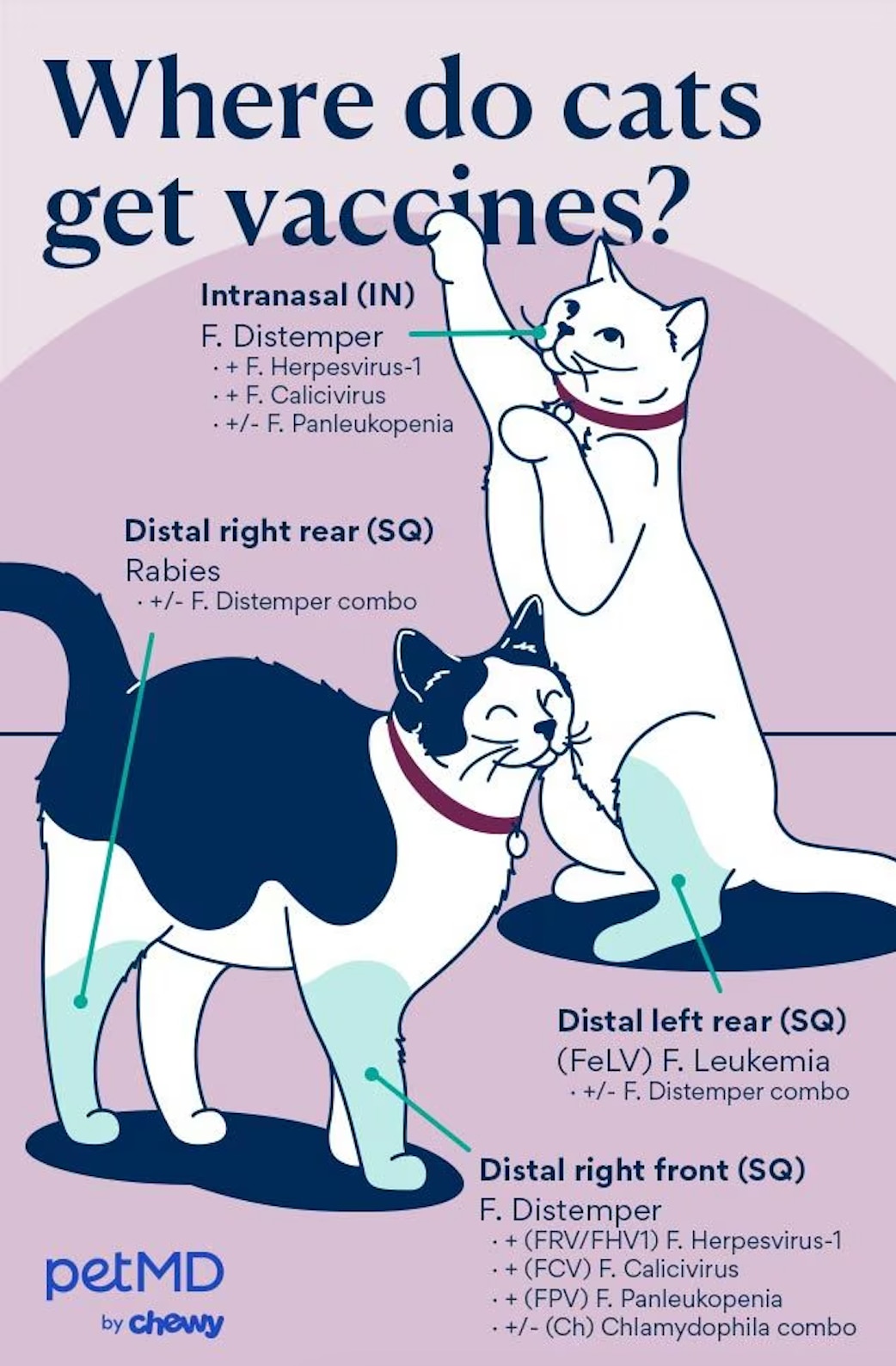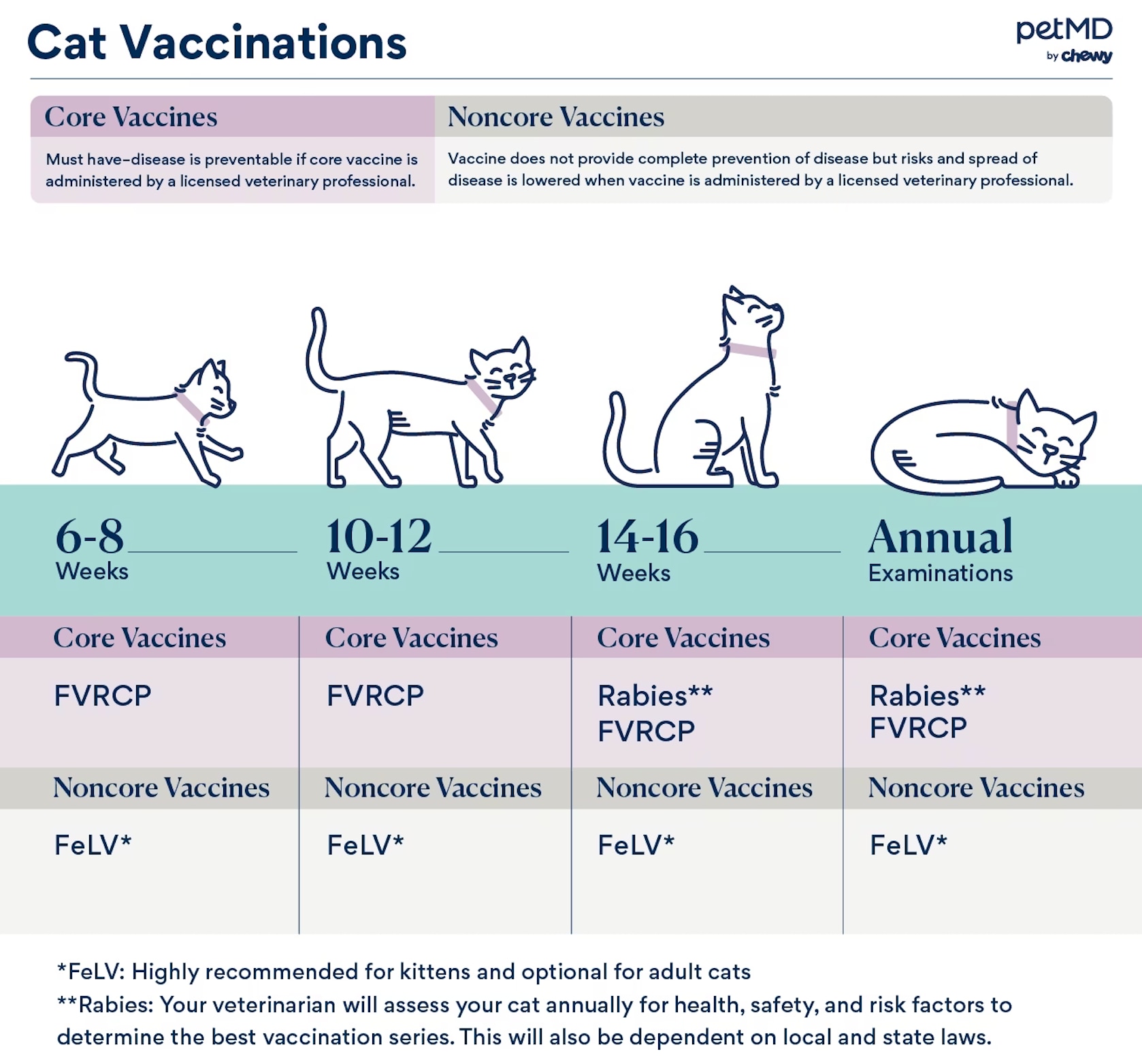

When it comes to medicine, there is no “one-size-fits-all” approach. And preventive care recommendations for cats are no exception.
Making sure your cat has the shots she needs and keeping up with booster shots is a critical part of being a pet parent.
The Feline Vaccination Advisory Panel regularly evaluates and researches cat vaccination developments to make science-based recommendations. The panel comprises dedicated feline veterinarians and scientists and is regarded as a reputable source of cat vaccination standards.
Their guidelines, published by the American Association of Feline Practitioners, are among the most trusted and utilized recommendations in the field.
They divide cat vaccines into two categories:
Core vaccines are those recommended for all cats, no matter where they live or under what conditions. Vaccines that are appropriate for some cats in certain circumstances are considered noncore vaccines (or lifestyle vaccines).
Cats are susceptible to many life-threatening illnesses.
Vaccination is the first and best method at protecting them from contracting many diseases such as feline leukemia (FeLV), rabies and panleukopenia, to name a few.
Most vets will highly recommend the FVRCP and rabies vaccines.
These diseases are highly infectious and seen worldwide. They are very dangerous to young cats, and the vaccines are considered to provide a good deal of protection with minimal risk.
The FeLV vaccine is recommended as a core vaccine for all kittens. Once a cat is an adult, the FeLV vaccine is considered non-core so long as there remains minimal risk for the cat.
Rabies vaccination is given every year or every three years, depending on state laws and the brand of vaccine used. Rabies is significant not only for its effect on the cat but because it's a zoonotic disease, meaning it's transmissible to humans. It can also be fatal.
While cats are not natural carriers of rabies, they can be infected by a bite from any infected mammal and then pass it on to others.
Rabies is endemic worldwide, and the vaccine is recommended for all pet cats.
The rabies vaccine is a core vaccine (per AAFP guidelines) and is required by law in most regions.
The other three core vaccines are combined into a single three-in-one vaccine called the FVRCP vaccine. This allows veterinarians to efficiently administer the vaccines all at once, instead of having to inject a cat three separate times in one visit:
If your cat is an indoor adult cat, FVRCP can be done every three years. If she is allowed outside, she is young or is a senior, your vet may recommend yearly FVRCP vaccines.
Cats heading into stressful situations, such as boarding, may benefit from a core vaccine booster seven to 10 days before.
Feline panleukopenia, also known as feline parvovirus, is a highly infectious disease with a high mortality rate in kittens.
While the disease usually starts with decreased energy and low appetite, it progresses to vomiting and diarrhea. The virus also kills off white blood cells, leaving the young cats even more susceptible to secondary infections.
Feline herpesvirus, also known as feline rhinotracheitis virus, causes severe signs of upper respiratory infection.
Some symptoms you can expect to see include sneezing, nasal congestion and discharge, and conjunctivitis. In some cases, it also causes oral ulceration and pneumonia.
After the cat recovers from the initial infection, the virus enters a latency period in the nerves. During times of stress, the virus can reactivate, and the cat can start to show signs of infection again—even if she hasn’t been re-exposed to the disease.
Feline calicivirus encompasses several viral strains that cause signs of upper respiratory infection, such as sneezing and nasal discharge as well as oral ulcerations.
FCV is thought to be associated with chronic gingivitis/stomatitis, a highly painful inflammation of the gums and teeth. Some of the more virulent strains cause hair loss and crusting on other parts of the body, as well as hepatitis and even death.
The FeLV vaccine works to protect your cat against the feline leukemia virus.
FeLV is found worldwide; transmitted through bodily fluids including saliva, urine, and feces, FeLV is spread when an infected cat comes into close contact with another cat that they groom or share bowls with.
Infection with FeLV is not an automatic death sentence. Many cats are fortunate to go into a regressive state and appear perfectly healthy throughout their lives, but some do not fare as well.
After a latent period lasting months or even years, the disease often progresses to a variety of associated conditions, such as lymphoma, anemia, or immunosuppression resulting in secondary disease.
The FeLV vaccine is recommended as core for kittens. The initial vaccination series consists of two doses spaced three to four weeks apart, followed by revaccination one year later for all adult cats.
However, based on most recent data, the Vaccine Advisory Panel recommends that subsequent vaccines may be administered based on risk: yearly for high-risk cats, and every two years for lower-risk cats.
Your veterinarian can assess your cat’s risk of FeLV infection and decide on an appropriate vaccination schedule.
Bordetella and chalmydia—both causes of upper respiratory infections—are considered non-core vaccinations in cats.
Not commonly given, these vaccines may be reserved in multi-cat houses, catteries, or shelter situations to limit or prevent exposure and outbreaks of respiratory disease.
Additionally, the feline infectious peritonitis (FIP) vaccine is generally not recommended as it hasn't shown a sufficient level of protection to be useful.

Many factors affect the likelihood of a cat developing an infectious disease. The factors that your veterinarian will consider to determine your cat’s vaccination schedule include:
Discuss your cat’s lifestyle and risk factors with your veterinarian to determine an optimal, individualized vaccination protocol.
Here are the general cat vaccination guidelines to use as a starting point:
Kittens (up to 1 year of age)
Adult and Senior Cats (over 1 year old)

Individual costs may vary, but a pet parent should expect to pay anywhere from $15 to $40 for cat vaccinations.
Some vaccines are more costly than others. Speak with your veterinarian as many clinics have wellness plans that make preventative care costs—such as vaccines—and the included office visit more affordable.
These plans can even be tailored to suit your cat's individual needs with core and non-core vaccines.
Unfortunately, vaccines are not without risk and even though the medical benefits certainly outweigh the risks, side effects can occur. It’s been estimated that reactions occur in 0.52% of cats, or 52 in 10,000.
Side effects from any vaccine can range from more common, but mild symptoms like soreness at the injection site to rare life-threatening shock and death.
Other symptoms include:
Yes! There are several life-threatening and even communicable diseases that cats are susceptible to. Vaccinations are an essential component of keeping your cat healthy.
Adult cats require less frequent vaccination than kittens—about once every one to three years.
Kittens require multiple vaccines over the course of the first few months of life starting around 6 weeks of age.
Vaccines do require a "booster" meaning that adequate levels of immunity are reached, which are often given every three to four weeks.
Vaccines contain modified (weakened or killed) pieces of virus or bacteria that that trigger the cat's immune system to develop antibodies which can help fight off future infection, if exposed to the disease.
Dr. Katie Grzyb received her Doctorate of Veterinary Medicine from Ross University in 2009. She continued her clinical training at.
Was this article helpful?